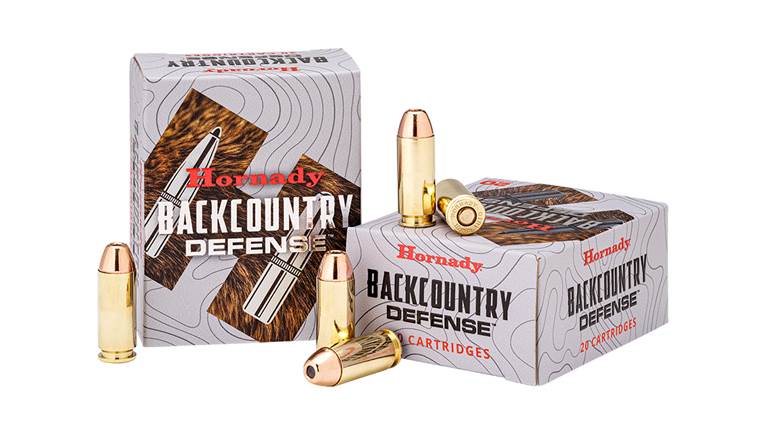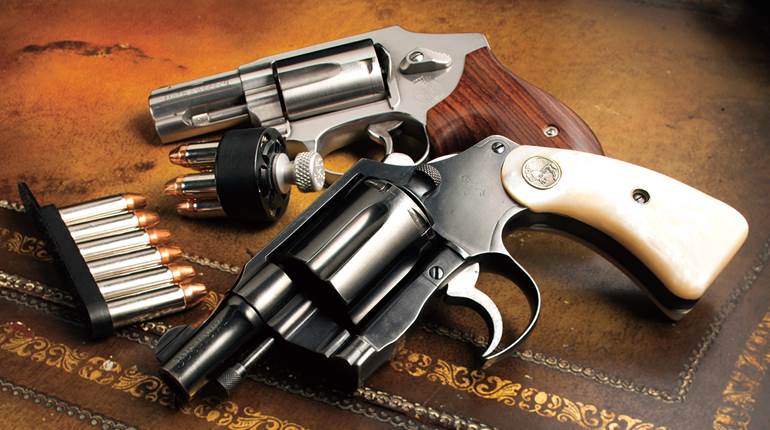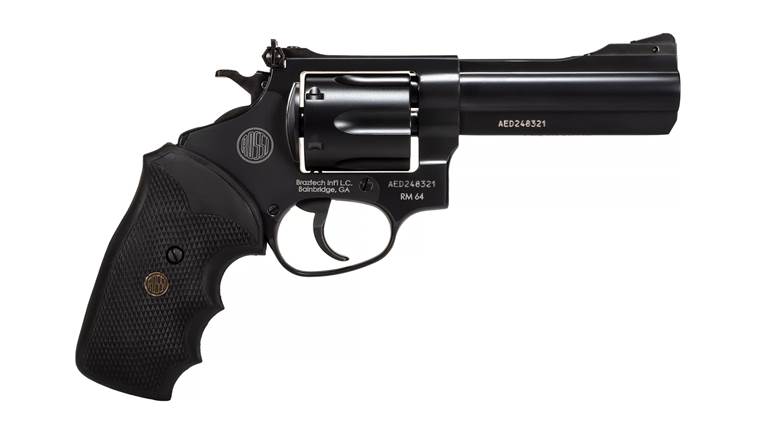
As most readers know, the .357 Magnum is an outgrowth of the .38 Special, which was itself an outgrowth of several older .38 cartridges that preceded it. Upon its introduction, the .38 Special was immediately recognized for its accuracy and ease of shooting. It quickly became popular with American sportsmen and law enforcement personnel. Despite the .38’s many attributes, “power” wasn’t one of them. Hunters and handloaders soon began experimenting with high pressure loads, trying to maximize the .38 Special’s performance. These efforts culminated in the mid-1930s with the introduction of the .357 Magnum. The .357 immediately became a favorite with hunters, outdoorsmen and those who appreciated its increased muzzle velocity over the .38 Special. 
Regardless of its success in the civilian world, the .357 Mag. may best be known for its use in police work. This one cartridge, along with service revolvers from Colt, Ruger and Smith and Wesson, came to symbolize the American law enforcement officer. Capable of penetrating automotive sheet metal and early body armor, the .357 Mag. quickly became known as a “fight stopper” and is the yardstick by which law enforcement ammunition is still judged to this day. The revolver, and the .357 Mag. cartridge, is no longer the choice for American police officers, but the combo is still a popular choice for hunting, sport shooting and personal defense.
Many firearms have been chambered in .357 Mag. over the decades and it has been used in rifles as well as pistols. However, the most common type of firearm built to handle the Mangum is the double-action revolver. Most double-action revolvers chambered in .357 Mag. fall into two categories. The first is the traditional full-size revolver. Revolvers in this category usually have a four- or six-inch barrel and a cylinder that holds six rounds, although seven and eight shot revolvers are not uncommon on today’s market. These revolvers are service handguns, being best suited for target shooting, open carry while hiking, fishing, et cetera. Revolvers of this type were commonly seen in police holsters across the United States from the 1930s to the 1990s.
The second category is the “snub nose” revolver. These little handguns commonly have a cylinder that holds only five cartridges and a barrel that's about two inches long. These were usually found with plain-clothed officers, police administrators and detectives. These short-barreled revolvers are made for maximum concealment and are a good choice when attire is worn that might not allow for easy concealment of a larger handgun. The beauty of the .357 Mag. revolver is its versatility. Being that the cylinder is cut to accept a Magnum case, the .357 can also be loaded with .38 Spl. My guess is that most of the concealment handguns chambered in .357 Mag. are taken to the range and used with .38 Spl. then loaded with .357 Mag. and tucked away in the nightstand or sock drawer in case of emergency. The fact is that the snubby’s size and weight simply does not make shooting full-power .357 a pleasant experience. Along these lines, an enduring belief is that the extra gunpowder in the .357 cartridge case is wasted in a short barrel. Is that really the case? Does the .357 not offer any real performance advantage over the .38 Spl. or .38 Spl. +P? Is a snub nose barrel simply too short to make use of the .357’s extra powder? 
I recently tested several .38 Spl. and .38 Spl. +P loads for accuracy as well as for terminal performance by firing these loads in two different revolvers. Continuing in a similar manner, I have now tested nine .357 Mag. loads using the same two firearms and the same testing protocols. Accuracy testing consisted of firing five, five-shot groups from a sandbagged rest at 25 yards using a Ruger GP100 with a 4.2” barrel. Terminal ballistic testing was conducted using 20” long blocks of organic 10 percent ballistic gelatin placed 10 feet from the muzzle. Terminal ballistics testing was done with a Ruger LCR with a 1.87” barrel. Accuracy results and terminal ballistics data are included on the accompanying tables.

Ballistic gelatin testing is one of the best methods available to assess a cartridge’s potential in a self-defense role. Gel has similar organic properties to flesh and tissue and provides a similar resistance. Gel gives the researcher a good idea of how a bullet is likely to perform in an animate target. Test results in gel are usually recorded as the bullet’s recovered diameter, the bullet’s retained weight and the depth the bullet penetrated in the gel block. Ideally, a self-defense bullet will penetrate to a minimum of 12” but no more than 18”. The bullet should also expand or “mushroom” as it penetrates, thereby increasing its chance of damaging a major blood vessel, organ or part of the central nervous system. Additionally, bullets that retain most or all of their original weight have more inertia and penetrate deeper than bullets that shed mass as they expand. 
Covering the face of the gel block with denim or a combination of denim and clothing further tests the bullet’s expansion properties. Of these three criteria, the penetration is the most important. Even if a bullet expands dramatically, it is unlikely to cause immediate incapacitation to an attacker if it cannot penetrate deep enough to shut down the central nervous system or cause rapid blood loss. Penetration is usually equated with velocity but that’s not always the case. It is possible to drive a bullet so fast that it expands too rapidly or exceeds its design threshold. When this happens, the bullet usually breaks apart, loses its mass and under-penetrates. On the flip side, a bullet that fails to expand, either due to a plugged hollow point cavity or a velocity that’s below the bullet’s design threshold, may pass through the target.

Like the .38 Spl., the .357 Mag. has a well-deserved reputation for accuracy. Most loads tested surprised me and I fired several groups of five rounds that came close to an inch at 25 yards. Some loads were fairly easy to control and some were not. The Buffalo Bore 140 -gr. load using the Barnes TAC XP bullet is a handful the highest velocities recorded. Not surprisingly, this load also produced the most felt recoil. Conversely, the Winchester 110-gr “White Box” was quite pleasant in both Rugers as was the Speer 135-gr. Gold Dot. 
Frankly, I had been expecting more consistent terminal results with the .357 Mag. However, my finding is that the .357 Mag., fired from the snub-nosed revolver, can be an effective choice for self-defense but is very much dependent on the ammo chosen. I suppose that’s true with any handgun, regardless of caliber. Of the nine loads tested here, only two achieved between 12 and 18 inches of penetration in both bare gel and gel covered with heavy clothing. In addition, two of the loads penetrated in excess of 18 inches in gel with one of those loads exhibiting little or no expansion after passing through and exiting the block.
It turns out the old idea that the short barreled .357 Mag. offers nothing that can’t be done with the .38 Spl. has some merit after all. The short barrel itself no doubt does present a challenge to ammo manufacturers, but this is something that can likely be overcome with a bit of Research and Development. One of the main factors making the modern 9 mm Luger an adequate choice for self-defense is bullet design. Ammunition and bullet manufacturers have worked hard to create a 9 mm bullet that penetrates deeply and expands reliably within the 9 mm Luger’s performance envelope. What might be possible with the snub-nosed .357 Mag., given the same attention? A dedicated .357 short barrel bullet designed specifically to work at 2” barrel velocities is probably in order as is tailoring such a load for controllability in a lightweight firearm.
Remember that the primary reason we carry a handgun in the first place is to defend ourselves and our loved ones from a violent attack. The beauty of the snub-nose revolver is its ease of concealment and the choice to carry one over a larger handgun is likely based on carry comfort rather than terminal performance. The ammunition chosen for that job is as important--possibly more important--than the handgun itself.
Accuracy
Penetration






































